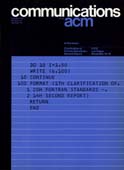October 1971 - Vol. 14 No. 10

Features
Toward an understanding of data structures
This paper presents a notation and formalism for describing the semantics of data structures. This is based on directed graphs with named edges and transformations on these graphs. In addition, and implementation facility is described which could be part of a programming language, which allows a programmer who has expressed the semantics of an algorithm in terms of the graphs to then specify the implementation of some of his data structures in order to gain efficiency.
Clarification of Fortran standards—second report
In 1966, after four years of effort, Fortran became the first programming language standardized in the United States. Since that initial achievement, study and application of the standard specifications have revealed the need for maintenance of the standards. As the result of work initiated in 1967, an initial set of clarifying interpretations was prepared and this clarification was published in Communications of the ACM in May 1969. That work has continued and has resulted in the preparation of this second set of clarifying interpretations. The nature of the maintenance and the new set of corrections to and interpretations of the standard specifications are reported.
Experiments with an automated instructional system for numerical methods
A comer system was developed at Purdue University to teach portions of an undergraduate course in numerical methods. Each instructional unit or lesson is divided into three modes of instruction which allow the student to press from a computer-controlled presentation to a student-controlled investigation. The system is designed as a classroom-independent course of study, and has been used for two semesters by students in lieu of conventional classroom instruction. Initial measures of effectiveness, student acceptance, and operational cost are the result of testing the system independent of instructor intervention. The system is operational on a CDC 6500 with teletype terminals.
Although the use of structured display files is widespread in interactive computer graphics, these structures present a number of problems which tend to restrict their generality and usefulness. This paper discusses some of these problems, and suggests an alternative approach to display system design which avoids the use of structured display files.
This technique employs display procedures to generate information for display. By including transformations within calls to these procedures it is possible both to simplify the specification of pictures and to speed up their generation. Display procedures permit picture elements to be defined conditionally and also facilitate the processing of inputs from pointing devices. The paper is illustrated by examples from a version of the EULER language in which display procedures were implemented.
User program measurement in a time-shared environment
A general discussion of the measurement of software systems is followed by a description of a hardware and software scheme for measuring user programs in a time-shared environment. The TX-2 computer at MIT Lincoln Laboratory was used for the implementation of such a system and the characteristics of this implementation are reported. A scenario showing the system in use is presented. Finally, it is shown how other time-sharing systems may provide similar measuring facilities.
Concurrent control with “readers” and “writers”
The problem of the mutual exclusion of several independent processes from simultaneous access to a “critical section” is discussed for the case where there are two distinct classes of processes known as “readers” and “writers.” The “readers” may share the section with each other, but the “writers” must have exclusive access. Two solutions are presented: one for the case where we wish minimum delay for the readers; the other for the case where we wish writing to take place as early as possible.



